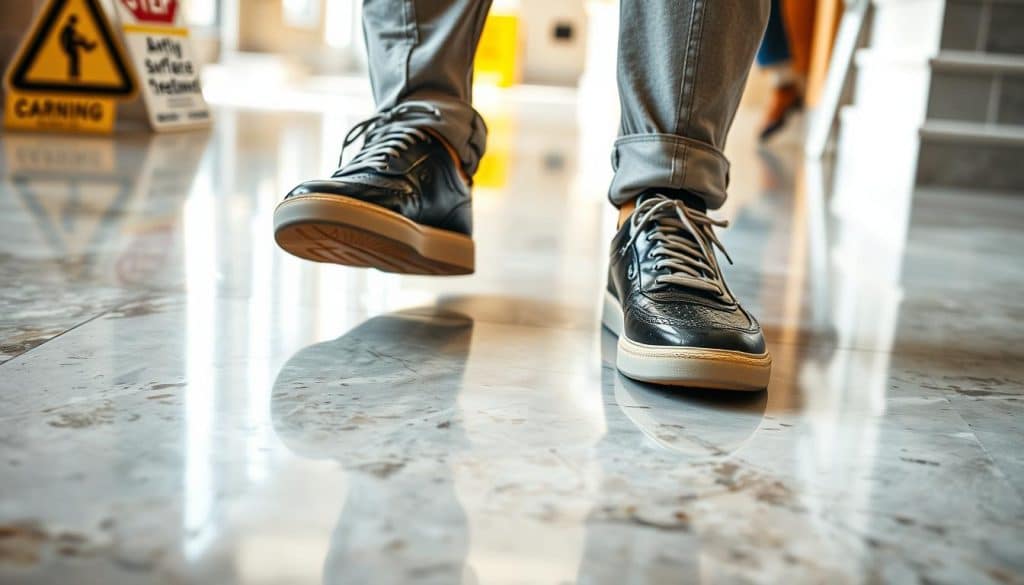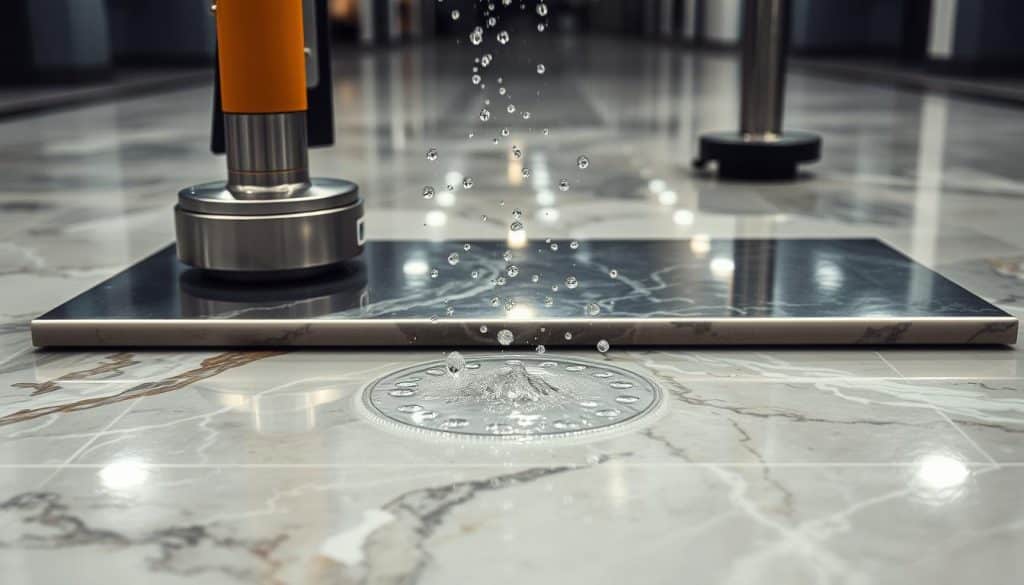Health and Safety Executive (HSE) reports show many injuries from slips and falls on hard surfaces in London. This highlights the need for regular anti-slip testing in homes and businesses. Marble and stone floors are popular for their beauty and strength. But, they can be dangerous when wet or not well looked after.
The demand for anti-slip treatments in London is increasing. This shows how important these services are for keeping places safe. Following slip resistance standards, like those from the UK Slip Resistance Group (UKSRG), is key for businesses. It helps make sure London marble floor safety and stone floor anti-slip solutions work well.
Key Takeaways
- Anti-slip testing is crucial for preventing injuries from slips and falls.
- There is a growing demand for anti-slip treatments in London.
- Adherence to UK Slip Resistance Group guidelines is essential for safety compliance.
- Both residential and commercial properties benefit from regular slip testing.
- Proper maintenance and anti-slip solutions enhance safety for marble and stone floors.
Why Anti-Slip Testing is Essential for Marble and Stone Floors
The slip resistance of marble and stone floors is very important. It’s crucial for both homes and businesses. Knowing its value helps keep everyone safe and follows the rules.

The Importance of Slip Resistance
Slip resistance is very important, especially for marble and stone floors. A study in the Journal of Health and Safety shows that testing can cut down slip accidents. It makes floors safer, preventing injuries.
Compliance with Safety Regulations
In the UK, flooring safety rules are strict. The Workplace (Health, Safety and Welfare) Regulations 1992 say floors must be checked and treated to avoid slips. London’s business sector has faced legal trouble for ignoring these rules.
Testing for slip resistance keeps people safe and follows UK safety laws. It shows how important it is by law.
Understanding Slip Resistance Testing in London
Keeping marble and stone floors safe is key, especially in busy places. An anti slip test is crucial for these surfaces. London has strict rules for checking slip resistance, and knowing these is important for property owners.
What is a Slip Resistance Test?
A slip resistance test checks if a surface might cause slips and falls. These tests are key for safe floors, whether wet or dry. In London, the Pendulum Test Device is often used. It measures how slippery a surface is, helping to keep marble and stone safe.
How is Slip Resistance Measured?
The floor slip testing methodology uses a few methods. The Pendulum Test Device is the main tool, but other tests like Surface Micro-roughness are also used. This extra test, suggested by the HSE, gives a full view of floor texture and slip risk, adding to London’s slip tests.

Also, insights from places like the Tile Council of North America (TCNA) show the importance of these tests worldwide. Their rules on friction levels help deepen our understanding of slip resistance test London methods. These methods together make sure floors in London are safe, helping everyone stay safe.
The Benefits of Anti-Slip Surfacing Services in London
Anti slip surfacing services in London bring many benefits to homes and businesses. They improve safety and offer lasting solutions for marble and stone floors.
Enhanced Safety
Anti slip services in London make floors much safer. The National Accident Helpline says slip and fall claims have dropped. This shows how vital it is to invest in safety measures.
Maintaining Aesthetic Appeal
Many people value the look of marble and stone floors. Anti slip treatments keep these floors looking great. London’s interior design experts recommend clear treatments that are safe and stylish.
Creating a Long-Lasting Solution
Anti slip treatments also last a long time. Facility managers save money because they need to fix or replace floors less often. These solutions keep floors safe and save on maintenance costs.
| Benefit | Description | Impact |
|---|---|---|
| Enhanced Safety | Reduction in slip and fall incidents | Improved occupant safety |
| Aesthetic Appeal | Maintains natural beauty of marble | Visually pleasing surfaces |
| Long-Lasting Solution | Durable treatments lead to fewer repairs | Cost savings on maintenance |
Common Causes of Slippery Marble and Stone Floors
Slippery marble and stone floors are a big worry for homes and businesses. Many things can make floors slippery, from the weather to how we clean them. Knowing what causes it helps us find ways to make floors safer.
Environmental Factors
The weather in London can make stone floors slippery. A study by the Building Research Establishment (BRE) found that rain and humidity cause algae and moss to grow. This makes floors slippery. Cleaning floors regularly is key to stopping this.
Improper Maintenance
Not cleaning floors right can also make them slippery. The Chartered Institute of Building Service Engineers (CIBSE) warns against using some cleaners that leave residue. Rinsing floors well after cleaning helps avoid this problem.
Wearing of Surface Finishes
Surface finishes can wear off over time, making floors less safe. Architectural journals say that natural wear means we need to reapply finishes to keep floors safe.
Types of Anti-Slip Treatments for Marble Floors
In London, flooring experts provide anti slip marble treatment options. These keep marble floor safety solutions high while keeping the floor looking natural. Penetrating sealers are a top choice. They make the marble surface safer without changing how it looks.
Companies like SlipTech and GripFactory are known for their custom marble floor solutions. They ensure both safety and beauty in luxury homes. Their treatments are made to fit each floor perfectly.
| Anti-Slip Treatment | Key Benefits | Suitable Environments |
|---|---|---|
| Penetrating Sealers | Maintains natural appearance, improved grip | Luxury homes, commercial properties |
| Bespoke Solutions by SlipTech | Tailored approaches, high safety standards | High-end residences, hotels |
| GripFactory Treatments | Customised for various marble types | Historical estates, public landmarks |
Also, estate managers of historical properties in London praise anti-slip treatments. These treatments boost safety and keep the marble floors looking original. They’re a top pick for keeping heritage floors in top shape.
Types of Anti-Slip Treatments for Stone Floors
Keeping stone floors safe is crucial, especially in busy places. There are many ways to make these floors less slippery. We’ll look at textured coatings, etching, and using anti-slip mats and treads.
Textured Coatings
Textured coatings are a top choice for making stone floors safer. Companies like SafeStep apply these coatings. They make the floor grip better without changing how it looks.
This is great for places where lots of people walk by.
Etching Treatments
Etching uses acid to make the stone surface rougher. The Tile Council of North America (TCNA) backs this method. It makes the floor safer without losing its natural beauty.
Etching works well in homes and offices. It’s a subtle but effective way to boost safety.
Application of Anti-Slip Mats and Treads
Anti-slip mats and treads are a fast and easy fix. They’re perfect for places like kitchens and entryways. The Institute of Occupational Safety and Health (IOSH) recommends them for their effectiveness and ease of use.
| Treatment Type | Advantages | Applications |
|---|---|---|
| Textured Coatings | Improves traction | High-traffic areas |
| Etching Treatments | Enhances slip resistance | Residential and commercial spaces |
| Anti-Slip Mats and Treads | Quick and practical | Commercial kitchens, entrances |
Anti-Slip Testing and Surface Treatments for Homes and Businesses
In London, keeping residential anti-slip solutions is key for property owners. It helps keep tenants safe and avoids legal issues. The Residential Landlords Association (RLA) highlights the need for these treatments in rental homes. Stone and marble floors can be dangerous without the right surface treatments.
For businesses, commercial floor safety London is a top concern. The London Chamber of Commerce and Industry (LCCI) advises businesses to invest in slip testing. This protects employees and customers, especially in busy places like Oxford Street.
By combining residential anti-slip solutions and commercial floor safety London guidelines, we get a full safety plan. Regular testing and the right treatments are essential for safety in London homes and businesses.
| Reasons for Anti-Slip Treatments | Benefits |
|---|---|
| Prevent Injuries in Homes | Reduces the risk of tenant and family member falls |
| Maintain Workplace Safety | Ensures compliance with workplace safety regulations and protects employees |
| Enhance Customer Experience | In high-traffic commercial areas, it ensures a safe and welcoming environment for customers |
| Brand Reputation | Positive safety measures improve public perception and trust in the business |
Innovations in Anti-Slip Technology
Anti-slip technology has seen big changes, making places safer and more efficient. New materials and methods are being used. They make surfaces safer and look good too.
New Materials and Methods
New anti-slip tech uses advanced materials like nano-coatings. These coatings offer better slip resistance and clean themselves. The Institution of Engineering and Technology (IET) backs these innovations.
Photoluminescent lines are also being used in London. They help see better in dark and are very slip-resistant. This shows how tech is improving safety and looks.
Case Studies of Successful Applications
Real-world examples show how well these techs work. King’s Cross Station in London is a great example. It has better safety and looks thanks to new anti-slip tech.
Places like this show the benefits of using the latest anti-slip tech. It makes spaces safer and more attractive.
| Innovation | Benefits | Application |
|---|---|---|
| Nano-Coating Materials | Enhanced slip resistance; Self-cleaning properties | Public and commercial spaces |
| Photoluminescent Demarcation Lines | Improved visibility during outages; Anti-slip features | Property developments |
| Innovative Applications at King’s Cross | Increased safety and aesthetic appeal | High footfall public areas |
Choosing the Right Anti-Slip Treatment Provider in London
Finding the right provider for anti-slip treatments is key for your marble and stone floors’ safety and longevity. Here are important factors to consider when picking expert anti-slip providers in London:
Experience and Expertise
When looking for anti-slip treatment providers, it’s crucial to find ones with lots of experience. The London Business Directory is a great place to find providers who have shown they can do a top-notch job. They can offer solutions that fit the specific needs of each floor type.
Customer Reviews and Testimonials
Customer feedback is very important in deciding if anti-slip services are reliable and effective. Websites like Checkatrade.com have many trusted floor treatment testimonials from happy clients in London. These reviews help you pick providers who have proven they can do a great job.
Certifications and Accreditations
It’s also important to check if the provider has the right certifications and accreditations. Bodies like Contractors Health and Safety Assessment Scheme (CHAS) and SafeContractor give certifications to businesses that meet high standards. Choosing certified slip testing services means you’re working with professionals who follow the highest safety and quality standards.
Steps Involved in Professional Slip Testing Services
Ensuring the safety and compliance of marble and stone flooring starts with a thorough slip and fall testing procedure. Each professional slip testing process involves intricate steps to deliver accurate, reliable results.
Initial Assessment
The first step is a detailed site visit. The technician inspects the flooring and spots areas that might be slippery. This aligns with Health and Safety Executive (HSE) guidelines for safety and compliance.
Conducting the Slip Test
After the initial assessment, the next step is the slip test. In the UK, the pendulum test is often used. It measures the floor’s dynamic friction to spot potential slip hazards.
Analysis and Reporting
The final step is the analysis and reporting. Specialists put together a detailed report from the slip test data. This report shows the slip resistance levels and suggests actions for safety and compliance. The analysis by London specialists ensures all necessary documentation is done right.
How to Maintain Anti-Slip Treatments over Time
Keeping anti-slip treatments effective is key for safe floors. You need to clean regularly, reapply treatments when needed, and watch for safety issues. Always follow the maker’s instructions and industry tips for the best results.
Regular Cleaning Practices
Stick to cleaning routines suggested by groups like The Flooring Industry Council. Cleaning often keeps anti-slip treatments working well. Choose cleaning products that won’t damage the treatment.
Reapplication of Treatments
Experts, like SlipGuard in London, say to reapply treatments as needed. How often depends on the floor. Getting advice from pros for a custom plan is a good idea.
Monitoring Slip Resistance
Checking floor safety is a continuous task. It includes testing slip resistance regularly. Journals suggest doing this every year to make sure floors meet safety standards. Regular checks help spot any slip resistance drops early, so you can act fast.
Investing in Anti-Slip Treatments: Cost vs. Benefit
Anti-slip treatments are not just about safety. They also save money. We’ll show how they can lead to savings and lower risks.
Insurance Premium Reduction
Property owners can get insurance benefits by choosing anti-slip treatments. The British Insurance Brokers’ Association (BIBA) says insurers might lower premiums for these efforts. This shows a lower risk, leading to long-term savings.
Reduce the Risk of Legal Claims
Using anti-slip treatments is key to legal risk management. Legal experts say these treatments cut down the risk of costly claims from slips and falls. This protects money and makes places safer for everyone.
Long-Term Savings on Repairs
Looking ahead, anti-slip investments are smart for the wallet. London’s top economists predict big savings on repair costs and injury payouts. This makes for a wise and cost-effective way to manage properties.
Customer Case Studies and Testimonials
We share stories from different sectors. They show how effective anti-slip treatments are. And how happy customers are with the results.
Commercial Properties
Managers in London’s financial area are very pleased. They say anti-slip treatments have made offices safer. This has cut down on slips and falls, making work safer and happier.
They also like that these treatments don’t ruin the look of the office. It’s all about safety without losing style.
Residential Properties
People living in fancy London flats are very happy. They love how anti-slip treatments keep their homes safe. But they don’t change the fancy look of their homes.
This mix of safety and style has made them very happy. They often tell others about it.
Public Spaces
The City of London has made parks and squares safer. They used anti-slip treatments to do it. This is part of their effort to keep everyone safe in public places.
It’s not just safer; people really like it. They feel more comfortable going out because they know they’re safe.
| Sector | Impact of Anti-Slip Treatments | Customer Feedback |
|---|---|---|
| Commercial Properties | Reduced employee slip incidents | High customer satisfaction |
| Residential Properties | Maintained luxury aesthetics while enhancing safety | Positive residential slip prevention testimonials |
| Public Spaces | Ensured safety in parks and squares | Widespread public support |
Frequently Asked Questions about Slip Testing in London
Locals in London often wonder about slip testing. We’ve gathered answers to common questions to help clarify things.
- What is the purpose of slip testing?
Slip testing checks the slip resistance of marble and stone floors. It makes sure they’re safe and prevent accidents. - How often should slip testing be performed?
You should test for slip resistance every year or after big changes to the floor. This keeps the anti-slip treatments working well. - Can slip resistance be measured on-site?
Yes, experts use special equipment to test slip resistance right where it matters. This gives accurate results for real conditions. - What factors influence the frequency of slip testing?
Things like how busy an area is, moisture, and the floor treatment affect how often you need to test.
Now, let’s talk about surface treatments:
- Are all anti-slip treatments compatible with marble and stone floors?
Yes, there are anti-slip treatments made just for marble and stone. They work well without harming the floor. - How long do anti-slip treatments last?
The life of anti-slip treatments depends on the type and how much the floor is used. Regular care and reapplying can make them last longer. - Will anti-slip treatments alter the appearance of my floors?
Many treatments keep the look of marble and stone floors while making them safer.
Knowing these answers can help London property owners keep their floors safe and looking good. Regular slip testing and the right treatments are key to a safe and lovely space.
Conclusion
Slip resistance testing is key for keeping marble and stone floors safe and looking good in London. It combines strict testing, following safety rules, and using new anti-slip methods. This work is led by safety experts who aim to lower risks in homes and offices.
Top architects and property developers in London stress the need for safe floors that still look great. They say it’s crucial to focus on anti-slip treatments to create a safe and careful environment. With custom solutions, owners can tackle slip risks without losing their floors’ beauty.
London offers many anti-slip treatments and expert advice for homes and businesses. By choosing special treatments and staying alert to slip risks, owners make their places safer. This effort makes London a leader in floor safety and style.
